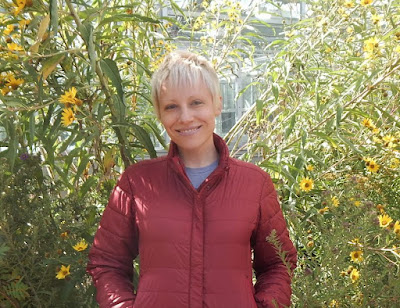It would be hard to imagine a more enthusiastic fan of the Port Townsend Marine Science Center than Ruby.
 |
Ruby arrives at Fort Worden for her
visit to the aquarium. Photo: Sarah Wright |
I first noticed Ruby visiting the museum one Sunday afternoon with her grandmother, Peggy Albers (a valued PTMSC volunteer), and grandfather. I saw a very small but nimble tow-headed little girl of about age two. She walked with purpose throughout the museum, and led her grandfather to the cormorant exhibit.
After talking with Peggy, I learned that Ruby visits PTMSC as often as she can, usually once a weekend on Sunday after she wakes up from her nap.
At home, she talks about the marine science center daily, her favorite books are tide pool field guides and octopus books, and she is disappointed that the tides are high during the day, when she can't go see anemones at North Beach.
We arranged to have Ruby visit the aquarium to learn more about her fascination, and more about what makes Ruby, Ruby.
I noticed her powers of observation first. Ruby, her mother Sarah Wright and grandmother arrived for their Monday morning visit and as she was ambling along beside the stroller her mom was pushing. Ruby suddenly stopped to peer into a crack in the decking of the pier.
“It's dark down there,” she said. She was referring to the dark water she could see below the pier.
Aquarium Curator Ali Redman welcomed us at the barn doors to the aquarium. We immediately stopped to check in on Sylvia, the giant Pacific octopus, and then Ali and Ruby spent some time assembling some shrimp-filled Duplo plastic blocks into an enrichment feeding toy for Sylvia.
.jpg) |
Aquarium Curator Ali Redman and Ruby
discuss adding shrimp to the Duplo blocks.
Photo: Sarah Wright |
After the feeding, we let Ruby lead us and I watched as her eyes lit up as she scrambled deftly on the ‘rocks’ that serve as benches and steps at the base of each tidepool tank.
As a child born during the midst of the pandemic, Ruby is just now emerging into public life, attending story hour with her mom at the library, and “the marine science center has been a big part of that, as well,” said Sarah.
“There is just such a sweet legacy aspect of it too, with my husband and I both having grown up here and having had our own experiences at the marine science center, it's been a really sweet thing to bring Ruby into it as well,” said Sarah.
When I asked Sarah how PTMSC has impacted Ruby’s life, she noted that PTMSC “makes everything so accessible … the fact that it is right on the dock over the water and we can just look into these tanks and see what we wouldn’t otherwise be able to see without snorkel gear – it’s just so amazing.”
Sarah, along with her husband Reed Aubin, are both “really passionate about climate justice and the environment.” Sarah is an avid paddle boarder and is an open water swimmer right here at Fort Worden State Park.
Part of their decision-making process to have a child in the current climate has been their hope to “cultivate and support her interest in our natural surroundings and the animals that inhabit it. Hopefully, this will contribute to a passion for conservation. If we can help her to just love all these things, then hopefully that will turn into her wanting to take care of it and protect it,” Sarah added.
At the aquarium, each time the sea water flowed forth into the surge tank, Ruby took note, saying “high tide” as the bubbles and froth entered the tank. Ruby carefully examined all of the tanks and was excited to see the wolf eel emerge from its hiding space.
 |
A moment of wonder with Ali Redman,
Ruby. and her grandmother Peggy Albers |
Ruby’s dedication has not gone unnoticed by PTMSC’s staff and volunteers. Ali Redman can often find time to engage with Ruby when she visits, and Sarah notes that Ai takes the time “to come out and speak to Ruby, really matter of factly, as a fully realized human being, which has been incredibly gratifying.”
Although Ruby makes time in her life for other fascinations (chiefly: garbage trucks), her mother notes that Ruby is an “equal opportunity lover” of all the animals in the exhibit and does not just reserve her adoration for the giant Pacific octopus.
“She loves everything equally and so she sees the animals and then she has a frame of reference, and is then excited to read books about sea animals and Pacific Northwest marine life. And that continues to tie it all together for her,” said Sarah. “Our trips create this common thread throughout the rest of her week.”
While Ruby shares her appreciation of the animals, her mom recounted a story that highlights the specificity of her admiration.
“Yesterday morning she was looking at a PNW marine life guidebook, and she got to the sea urchin page. In her little toddler voice, she told me, passionately, ‘sea urchins are really really pokey. I like sea urchins so much!’
We hope that Ruby’s fascination with marine life and the Salish Sea continues, and we are thrilled to welcome this three-generation group into the exhibits whenever possible.
Written by Volunteer Program Coordinator Tracy Thompson

.jpg)
















.JPG)








